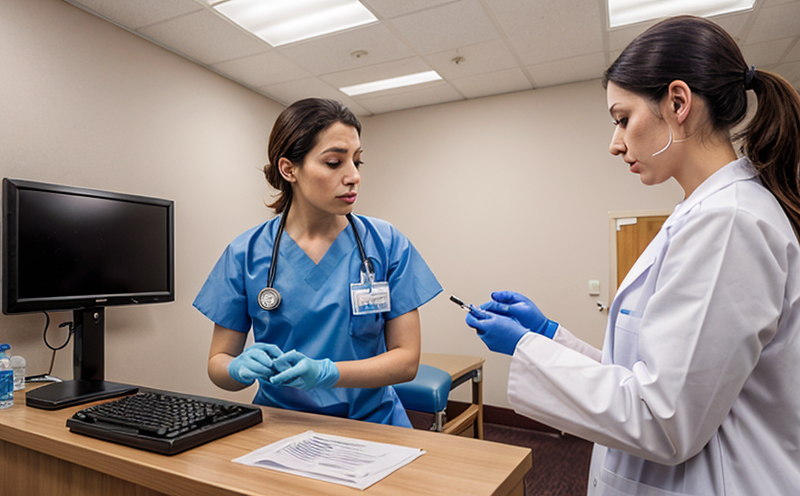Veterinary Drug Endocrine Disruption Testing in Aquatic Models
Testing veterinary drugs for endocrine disruption using aquatic models is a critical aspect of ensuring safe and effective pharmaceuticals. This testing is particularly important given the potential for aquatic organisms to be exposed through various environmental pathways, such as wastewater discharge or runoff from agricultural areas. The use of aquatic models allows us to assess not only direct toxicity but also the endocrine-disrupting potential of veterinary drugs.
The testing process begins with a thorough review of available literature and regulatory guidelines. This ensures that our tests are aligned with international standards, such as ISO 17025 for laboratory accreditation and OECD (Organisation for Economic Co-operation and Development) guidelines on test methods. Once the protocol is established, we select appropriate aquatic species based on their sensitivity to endocrine disruption and their relevance to the environmental conditions where these drugs might be used.
Specimen preparation involves collecting water samples from controlled environments that mimic real-world conditions as closely as possible. These samples are then inoculated with various concentrations of veterinary drugs, ranging from low levels indicative of environmental exposure to higher doses to determine threshold effects. The aquatic models we use include fish species like fathead minnows (Pimephales promelas) and rainbow trout (Oncorhynchus mykiss), as well as amphibians such as Xenopus laevis.
Once the specimens are exposed to the drugs, they undergo a series of physiological assessments. These include monitoring hormone levels using sensitive analytical methods like enzyme-linked immunosorbent assays (ELISAs) and liquid chromatography-tandem mass spectrometry (LC-MS/MS). We also measure changes in reproductive behavior, growth rates, and development stages to identify any potential disruptions in endocrine function.
The testing process is rigorous and involves multiple replicates to ensure robust data. Our laboratory adheres strictly to ISO 17025 standards for quality management systems, which guarantees the reliability and validity of our results. This includes meticulous documentation of all experimental conditions, sample handling procedures, and analytical methods used.
The results from these tests are then analyzed using statistical tools to determine whether there is a significant difference in the health parameters between control groups and those exposed to veterinary drugs. Any deviations from normal levels indicate potential endocrine-disrupting effects that need further investigation. This information helps regulatory bodies make informed decisions about drug approval or modification.
In addition to providing scientific evidence, this testing also contributes significantly to environmental protection by identifying safer alternatives for aquatic ecosystems. By understanding how veterinary drugs interact with aquatic life, researchers can develop more targeted treatments that minimize adverse impacts on non-target species.
Industry Applications
The results of our veterinary drug endocrine disruption testing in aquatic models have broad applications across the pharmaceutical industry. Regulatory bodies such as the European Medicines Agency (EMA) and the Food and Drug Administration (FDA) require these tests to ensure that new drugs do not pose risks to human health or the environment.
- Pharmaceutical companies utilize our services during drug development stages to identify potential endocrine-disrupting compounds early in the pipeline.
- Animal health corporations leverage our expertise to refine existing products, ensuring they meet stringent regulatory requirements.
- Agricultural businesses benefit from our insights into minimizing contamination of waterways with veterinary drugs.
The data generated by these tests supports the development of safer and more sustainable agricultural practices. For instance, understanding which drug formulations are less likely to cause endocrine disruption can lead to more precise dosing protocols that reduce unnecessary exposure in both terrestrial and aquatic environments.
Quality and Reliability Assurance
- We maintain strict adherence to ISO 17025 standards for our laboratory operations, ensuring the highest level of accuracy and precision.
- All analytical instruments are calibrated regularly according to manufacturer specifications using traceable reference materials.
- Data handling is governed by rigorous protocols that ensure traceability and integrity from sample collection through final report generation.
The quality assurance team conducts regular audits of all procedures, including specimen preparation, exposure conditions, and data analysis. This continuous improvement process ensures that every test adheres to the highest scientific standards.
Environmental and Sustainability Contributions
Veterinary drug endocrine disruption testing in aquatic models plays a crucial role in protecting environmental health. By identifying potential risks early, we enable industries to adopt more sustainable practices that minimize harm to wildlife.
The findings from these tests contribute to the development of safer alternatives for both terrestrial and aquatic ecosystems. For example, if certain veterinary drugs are found to be harmful to specific species, researchers can explore alternative treatments that have lower environmental impact. This not only promotes biodiversity but also supports sustainable agricultural practices by reducing unintended consequences.
Moreover, our work helps prevent the accumulation of persistent organic pollutants (POPs) in water bodies, which can have long-lasting effects on aquatic ecosystems and human health. By providing reliable data about drug behavior in environmental contexts, we support informed decision-making that balances therapeutic benefits with ecological sustainability.





